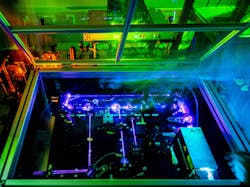Exploiting quantum properties of light for quantum holography
A group of Fraunhofer researchers in Germany, who set out to explore how to combine concepts of quantum imaging with those of classical imaging, have demonstrated a new way of doing holography: quantum holography with undetected light.
Their goal was to enhance spatial resolution in the widefield imaging mode through a better optical design and larger-aperture nonlinear crystals. They also wanted to demonstrate the principle over various spectral ranges, ideally using the same setup to perform hyperspectral quantum imaging with undetected light over a large spectral range (see figure).
“The combination of phase-shifting holography with quantum imaging allows us to have new requirements—the reference and sample beam no longer need to be coherent to each other—for holography, which enables holography with undetected light,” says Markus Gräfe, head of the Quantum-Enhanced Imagery Group within the Emerging Technologies Department at the Fraunhofer Institute for Applied Optics and Precision Engineering (Fraunhofer IOF; Jena, Germany).
Thinking in the opposite direction, he points out that the phase-shifting algorithm makes quantum imaging with undetected light handier to use “because it allows us to extract the full phase and amplitude information of a sample in a very fast and efficient way.”
Induced coherence without induced emission
How does it work? “We use a nonlinear interferometer,” Gräfe explains. “There, the nonclassical light is in terms of two correlated light beams, which have different wavelengths. By using the quantum effect of ‘induced coherence without induced emission,’ it becomes possible to use one of the light beams for illumination inside the interferometer. And by applying a phase-shifting algorithm, holographic images can be obtained, which makes our approach more versatile for biomedical imaging.”
Nonclassical light is light that must be described by quantum physics—it can no longer be described by classical electrodynamics. “Nonclassical states of light are the quantum states of such nonclassical light—and there are many,” says Gräfe. “We use photon-pair states/two-photon states generated via a process called ‘spontaneous parametric down conversion.’ The nonclassical feature is that those two-photon states have two photons, which are spatially correlated or, in our case, even spatially entangled. Since there is a stream of such photon pairs, they form the correlated light beams mentioned earlier.”
Thanks to the nonlinear interferometer, they can exploit “induced coherence without induced emission,” an effect based on the indistinguishability of two possibilities for the two-photon state/wavefunction. These two possibilities—having interacted with the object or not—allow the nonlinear interferometer, via the correlation between the two beams, to “see” the image of the object with the nonilluminating light beam.
“Who, outside of quantum optics researchers, would have guessed we could do holography with undetected light? This means light that illuminates the object/sample isn’t detected at all,” Gräfe says. “And the detected light never interacted with the object/sample. This ‘quantum imaging with undetected light’ is now combined with classical phase-shifting holography and is suitable for more applications.”
The really fancy part, he adds, is how they can spectrally separate illumination and detection of an object. Imagine you want to observe some protein or lipid distribution within a biological sample. “You would do this with mid-IR light, which is difficult to detect,” says Gräfe. “We solve this, since with our method we illuminate with mid-IR but detect visible light, which is easy to detect.”
Future uses
As far as applications in the future, their method can enable imaging, spectroscopy, and sensing over spectral ranges where no detection is otherwise possible, is very challenging, or has poor performance. “Detection is always carried out very efficiently (it’s also cost-efficient) within the visible range with standard technology, while the interaction/illumination with/of the sample is carried out within the extreme spectral range that is difficult to detect,” Gräfe notes. “In particular, the mid-infrared spectral range is of interest because it’s difficult to detect—it’s essential for chemical-selective biomedical imaging.”
The next step is to “improve the performance and build a scanning microscope system for mid-IR microscopy with visible light for biomedical imaging,” says Gräfe.
About the Author
Sally Cole Johnson
Editor in Chief
Sally Cole Johnson, Laser Focus World’s editor in chief, is a science and technology journalist who specializes in physics and semiconductors.

